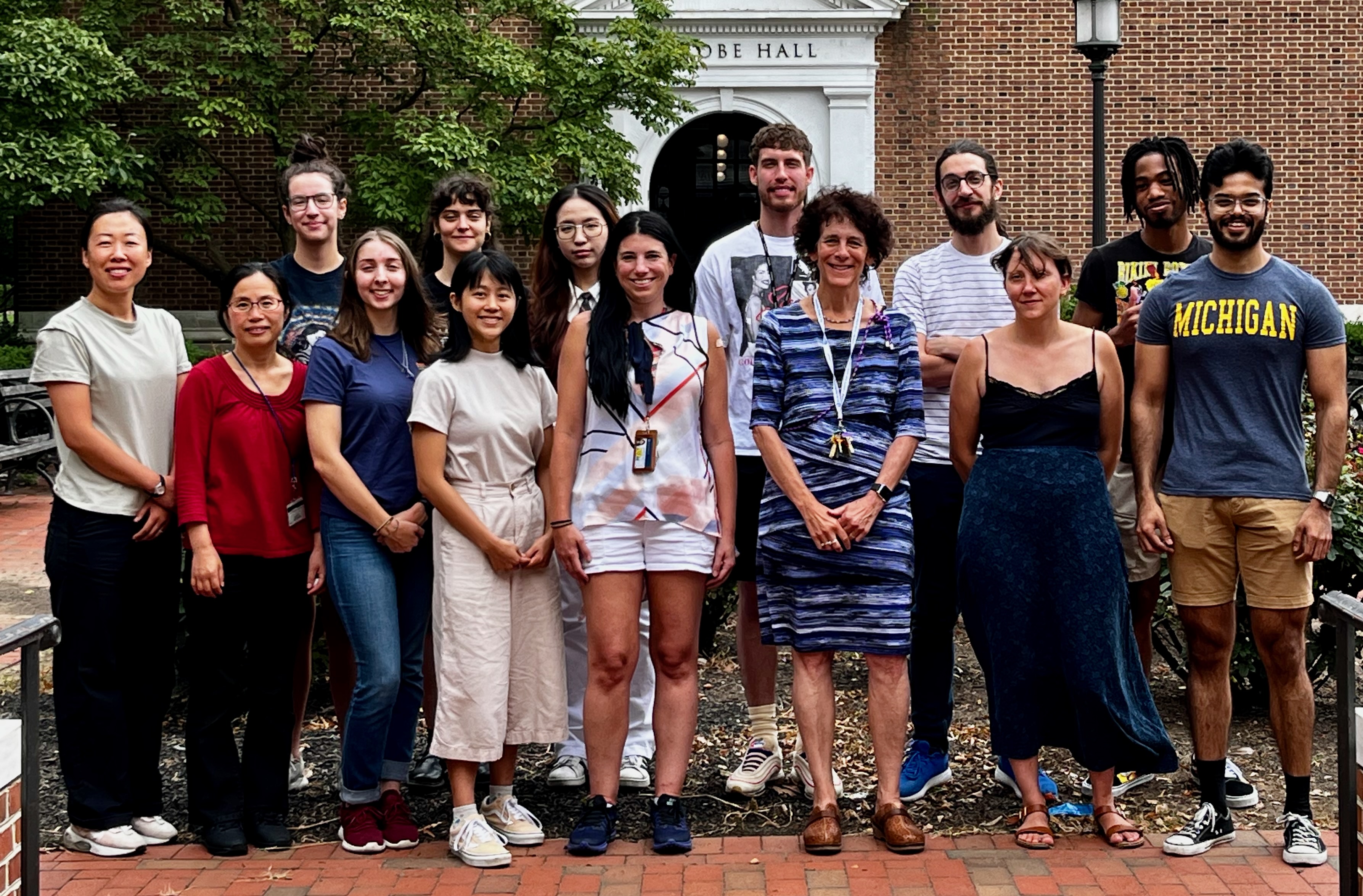
 Cynthia F. Moss, Ph.D. Principal Investigator Current Biology Q & A 2021 |
The importance of sensory-guided behaviors captured my interest early in college, and ever since, I have investigated visual, gustatory, tactile and auditory systems in diverse species. My undergraduate thesis research at the University of Massachusetts with Professor Vincent Dethier characterized changes in gustatory responses to sucrose-quinine mixtures with hunger states in the blowfly. Later, as a research technician at the University of Washington, I contributed to research on the development of spatial vision in human infants and rod-cone interactions in adults. In graduate school at Brown University, my first studies investigated the influence of spatial contrast on single neuron responses to luminance changes. I later conducted neuroethological studies of hearing with Professor Megela-Simmons, and my dissertation research exploited a reflex modification method to measure absolute hearing sensitivity and critical ratios in the green treefrog. As a postdoc, I first carried out experiments on target ranging by echolocation in bats at the University of Tübingen with Professor Hans-Ulrich Schnitzler and later at Brown University with Professor James Simmons. The echolocating bat has served as the primary research subject in my lab over the years, and it now serves as a powerful animal model to investigate a broad range of topics, which include auditory, visual and somatosensory processing, spatial perception, attention, learning, memory, navigation, sensorimotor integration, social communication, predictive target tracking, and flight control. The diversity of research questions investigated in my lab emerges from undergraduates, graduate students and postdocs, who pursue their individual interests, and a team approach to build connections across scientific problems. |
 Susanne J. Sterbing, Ph.D. Assistant Research Professor JHU | UMD | Google Scholar |
Echolocating bats exhibit an extraordinary array of solutions to the challenges of maneuvering in cluttered environments, pursuing evasive prey, taking food from water surfaces, and landing on the ceiling or walls of confined spaces (holes in trees, rafters in attics, ceiling of caves). Somatosensory signaling of airflow along the wing membrane contributes to this exquisite flight control, but successful navigation in the dark must also engage multisensory processes that guide a suite of adaptive motor behaviors. I am interested in the multisensory components of this sophisticated model system that are involved in flight control, like auditory (sonar), tactile, and proprioceptive components by analyzing behavioral changes, i.e., adaptive flight trajectories and vocal-motor patterns. |
 Kirsten (Kisi) Bohn, Ph.D. Lecturer Assistant Research Professor |
I am interested in the evolution of vocal and social complexity. Everyone would agree that humans have the greatest vocal complexity known. However, even though a great deal of research has focused on speech production and language evolution, these topics remain highly controversial. This is in part because only a handful of animals use complex vocal signals. Indeed, birdsong has been our main model for the neurophysiology of speech and the evolution of complex vocalizations. Our goal is to add bats as a comparative model to better understand the production and evolution of vocal complexity, including human speech. Bats can also serve as a model for social complexity and cooperation as there are over 1200 species of bats the majority of which are highly social. |
 Jennifer Lawlor, Ph.D. Postdoctoral Fellow |
My work focuses on processing and extraction of relevant information of auditory scenes for goal-directed behavior. I use a combination of behavioral models (humans, bats, mice...) to study how state-dependent changes and context can influence perception first, leading to optimization of decision-making and ultimately output behavior. |
 Dimitri Skandalis, Ph.D. Postdoctoral Fellow |
I study how animals use and combine multiple sensory modalities to guide movement through diverse environments (sensory fusion). In the Moss lab I am working to understand how different species of bats' reliance on combined visual and auditory information when executing rapid flight maneuvers. I aim to use these results to better understand closed-loop behaviour control, in collaboration with the Cowan lab. |
 Davi Drieskens, Ph.D. Postdoctoral Fellow |
|
 Nikita Finger Postdoctoral Fellow |
I am interested in how animals perceive their world using different senses. In the Batlab at JHU, I study how bats gather information from their environment and form spatial maps using different sensory modalities (i.e. echolocation and vision). This makes bats an ideal model to study multisensory integration. My work also investigates how bats adjust the acoustic parameters of their calls (such as intensity, frequency, and sonar beam) when orienting in different environments and when performing different tasks (such as foraging). |
 Aditya Krishna Graduate Student |
I am a behavioral biologist at heart. After spending the bulk of my undergraduate years exploring the sensory biology of bats, moths, and crickets, I recently crossed the sea to explore the neural mechanisms of behavior. Over three decades of electrophysiological research have revealed the importance of hippocampal formation in the representation of space. However, little is known about how rapid shifts in attention modulate hippocampal spatial representations. Due to the lack of explicit metrics in monitoring the moment-to-moment attentional changes in freely moving rodents, the leading model system for hippocampal research, this fundamental problem has remained unanswered. The echolocating bat presents a special opportunity to investigate this challenging problem, utilizing the bat's acoustic gaze as an explicit metric of its spatial attention. Ultimately, I aim to uncover the hippocampal mechanisms associated with naturalistic behaviors, such as foraging in a complex environment with conspecifics, prey, and obstacles. |
 Clarice Diebold Graduate Student |
Bats dynamically shift call structure in order to track and intercept targets, often in cluttered or noisy environments. I am interested in how bats are able to interpret returning echoes to generate internal models of target motion, and how they maintain these representations when sensory access is restricted. Working in collaboration with Dr. Angeles Salles, we aim to determine if bats use predictive or non-predictive strategies when tracking target motion and evaluate how they might change strategies when the prediction is challenged by occluding a portion of the target trajectory, akin to an insect prey darting behind a tree. Ultimately, I am to examine over what time scales bats are able to integrate sensory information to generate and update internal models of target motion. |
 Jared Magdiel Jaroszewski Post-Bac Intern |
|
 Keegan Eveland Post-Bac Intern |
Bats possess remarkable abilities to navigate through complex three-dimensional environments by integrating multiple sensory inputs. In my undergraduate work, I investigated how memory impacts the use of current sensory information in Egyptian fruit bats, and the acoustic strategies used by Brazilian free-tailed bat swarms to avoid conspecific collision in a dense environment. My graduate research probes how bats prioritize sensory information, such as echolocation and vision, and the mechanisms by which bats fuse this information to navigate natural tasks (such as foraging). Through a blend of behavioral and neural approaches, I seek to unravel the intricacies of bat sensory processing and navigation. |
 Jake Sayles RESEARCH SPECIALIST |
|
 Michael G. Wilkinson PhD Student |
Mechanical Engineering, LCSR, LIMBS Lab, Batlab (affiliate). |
 Victoria Liu Undergraduate Student |
Undergraduate Student, Batlab. |
 Wendy Chen Undergraduate Student |
Undergraduate Student, Batlab. |
 Melanie Urgiles Undergraduate Student |
Undergraduate Student, Batlab. |
 Diego Cintron Undergraduate Student |
Undergraduate Student, Batlab. |
 Megan Humphries Undergraduate Student |
Undergraduate Student, Batlab. |
 Alisa Sivertsen Undergraduate Student |
Undergraduate Student, Batlab. |
 Alara Kaplanoglu Undergraduate Student |
Undergraduate Student, Batlab. |
 Isabella Diaz Undergraduate Student |
Undergraduate Student, Batlab. |
 Wei Xian Lab Manager |
I am interested in how bats adapt their echolocation call
to dynamic changes in the acoustic environment and how they navigate in the complex 3-D environments.
I am also interested in how they communicate with each other during foraging. |
Collaborators
Kishore Kuchibhotla
Timothy Horiuchi
P.S. Krishnaprasad
Ellen Lumpkin
Rachel Page
Shihab Shamma
Jonathan Simon
Annemarie Surlykke
Nachum Ulanovsky
Yossi Yovel